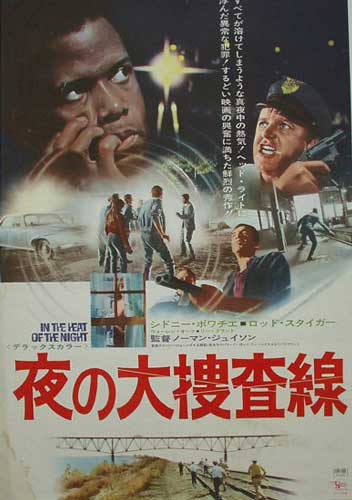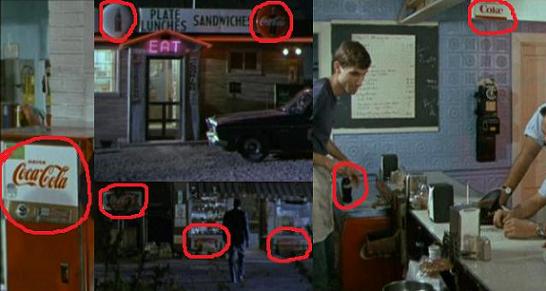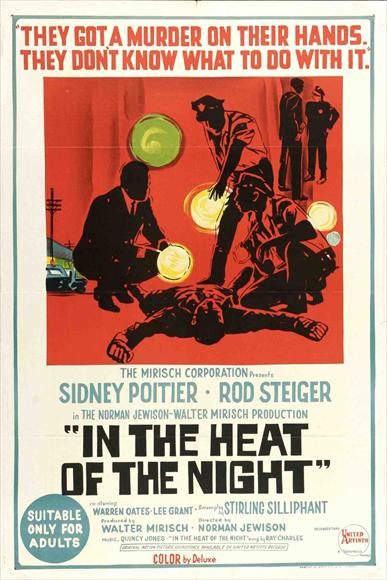
[THE CHALK-OUTLINE]
In The Heat Of The Night (1967): Breakdown by Kain424
A black Northern detective helps a white Southern police chief solve a homicide.
[THE EXECUTION]
While many movies were made featuring racial issues and black protagonists in the 60s and 70s, perhaps none were so critically accepted as In The Heat Of The Night. Featuring Academy Award winning black actor Sidney Poitier and two-time Academy Award nominee Rod Steiger, the film contains a powerhouse of acting talent from the era, with small roles also given to Warren Oates and Lee Grant.

That being said, it’s surprising how much everyone other than Rod Steiger underplays everything. Poitier plays his role as straight as possible, a living metaphor for the very opposite of so many black stereotypes. He almost never gives in to his emotions, and when he does it’s just another glimpse at a real human character. Steiger offsets his co-star by playing the role of a racially challenged police chief with an ever-increasing aggressiveness. He has his own faults (of which, ethnocentrism is the most prominent), but is allowed to grow as a person and learn to admire the black detective in his white town.
While the motive for the characters’s crossroads is the scene of a murder, the movie is really about racial integration and equality. Detective Tibbs is arrested and treated with apprehension because he is black. Chief Gillespie must overcome his prejudices in order to accept the help of this outsider. Things are only worsened because of Gillespie’s jump-to-conclusions demeanor and general lack of talent or skill. He sees the intelligent and methodical Tibbs not just as a threat to the town’s unsaid segregation policies, but to his pride as an authority figure as well.

The two actors work their craft well, emphasizing Sidney Poitier’s quiet performance with Rod Steiger’s shouting and nervous chewing of gum. But it’s with the two characters’ body language that the film really excels. The two sit together in the same shots several times, but often facing away from one another. As they bond, the two begin looking more relaxed together and MISTER Tibbs is even seen sharing a moment in Gillespie’s home. The film shows the beginnings of the buddy-cop genre, and pre-dates the black cop/white cop combo of Lethal Weapon by two decades. I wouldn’t call it a buddy-cop movie, but the themes and many of the moments are definitely there.

The Action is all very tame, with the sole car chase of the film not amounting to anything better than a dented fender and a foot race. The one fight scene (which immediately follows the car chase) is less an actual battle than a stand-off. Guns are drawn, shots are fired, but only a couple people die in the entire film. So I wouldn’t call what happens a gun fight, but the tension is there.

On a side note, either Coca-Cola funded this film’s production or they’re trying some sort of metaphor about white people and dark-colored drinks. Not sure what’s going here. Aside from the constant barrage of Coke logos and Coke drinking characters (seriously, it’s a lot!), the score by Quincy Jones is quite memorable. While the themes of racial equality and doing away with stereotypes would be all but jettisoned by the blaxploitation genre, the funktastic score style would be fully embraced. The opening song, sung by Ray Charles, is particularly noteworthy.
All in all, In The Heat Of The Night is decent movie, if a little slow. The racism prevalent in the film is still striking and the acting is naturally great. There are some memorable lines and Steiger actually won the Oscar for his portrayal of the chief. Is it worth the hype? Maybe a little. I guess I’d say to check it out.
[HOW BAD-ASS ARE THE MAIN CHARACTERS?]

Sidney Poitier is Detective Virgil Tibbs
Tibbs is pulled into a murder case by way of circumstance, and as such is at first more than a little reluctant to help out the racist southern police force of Sparta, Mississippi. His need to prove himself to the whites and then, later, his need to simply do the right thing eventually bring him to solve the case.
Tibbs is intelligent, methodical, collected, but has something to prove. He can be sociable when he wants, but resents his situation. He is the driving force in the investigation, but only when he is able to overcome his own emotions can he see the truth.

Rod Steiger is Chief Bill Gillespie
Quick to make foregone conclusions and ride them to embarrassing lengths, Gillespie is an aggravated emotional animal. Pressured by outside forces, he is also reluctant to have Tibbs assist in the murder investigation. Gillespie is ultimately an outsider even in the town he presides over. He lives a lonely life, drinking himself to sleep at night and being mocked and disobeyed by the deputies under him.
Still, despite the lack of skill needed for his profession, Gillespie understands and recognizes his weaknesses as an officer and as a mortal man. He speaks bluntly and to a purpose, even if it isn’t always the right one. He is able to overcome his unsympathetic behavior and learns to admire, rather than fear, the black detective in his white town.
[THE BODY COUNT: 2]

Pretty scant here. We see a body at the start of the movie, a man gets shot later, and an abortion almost happens. The violence is all pretty tame, though. In fact, the most blood we see is on a small character’s elbow.
[MOST SATISFYING ASS-KICKING]
While not really an ass-kicking in the traditional sense, the moment when Virgil returns the racist rich man, Mr. Endicott’s bitch slap is pretty damn satisfying. Endicott turns a conversation about flowers into an awkward rambling about blacks and their need to be taken care of. Naturally this angers Virgil Tibbs, who insinuates that Endicott may be the murderer they are looking for. This show of disrespect causes Endicott to make a meeting for Tibbs’ face with the back of his hand.

Tibbs immediately returns the gesture, and Endicott begins weeping like a bitch as Tibbs leaves the scene.
[DUDESWEAT AND MACHISMO]
Two male characters share a jail cell together and nothing happens. Oh well, it was the 60s.
[EXPLOITATION AND MISOGYNY]
Though the focus of the movie is entirely on racism, they still make time to show an ill-educated girl of 16 tease her neighbors with some naked night-time strolling around her house. And later, the young lass’s underaged womb becomes a central part to the ensuing investigation of murder, lies and deceit.

Plus, she’s a Coke whore.
[EPIC MOMENT AND BEST ONE-LINER]
EP-M: The Realization
Gillespie finds Tibbs in the field where Colbert’s factory is to be built. Gillespie is still certain the killer is his deputy, Sam, but Tibbs thinks otherwise. The chief has the motive (money) and thinks Sam drove his police cruiser up to the field, clubbed Colbert in the head, then drove the victim’s own car back to town and dumped the body in the street. But Tibbs tells him he has the wrong man. When Gillespie asks Virgil what makes him so sure, Tibbs drives a hole right through the chief’s theory, blunt in its implications and clear in its obviousness:
“Sam couldn’t have driven two cars!”
For the final time, Tibbs proves Bill Gillespie wrong. But for the first time, removed from his office and political pressures, the chief understands and begins to respect the black detective.
THE LINE
Gillespie, after having been proven wrong by the evidence provided by Tibbs for the innocence of a suspect, takes the opportunity to insult the wounder of his pride.
Gillespie: “Virgil, that’s a funny name for a nigger boy to come from Philadelphia. What do they call you up there?”

“They call me MISTER Tibbs!”
[THE MORAL OF THE STORY]

To clearly see the truth, one must first overcome their prejudices.
[THE CHECKLIST: 10 outta 25]
[ ] Athlete(s) Turned “Actor”
[ ] Clinging To The Outside Of A Moving Vehicle
[ ] Crotch Attack
[X] Dialogue Telling Us How Bad-Ass The Main Character(s) Is/Are
[ ] Ending Featuring An Ambulance, A Blanket or A Towel
[X] Factory/Warehouse
[ ] Giant Explosion(s)
[ ] Heavy Artillery
[X] Improvised Weapon(s)
[ ] Macho Mode(s) Of Transportation
[X] Main Character Sports Facial Accessory(s) [Steiger’s cop sunglasses]
[ ] Manly Embrace(s)
[ ] Notorious Stunt-Man Sighting
[ ] Passage(s) Of Time Via Montage
[X] Politically Fueled Plot Point(s)
[ ] Senseless Destruction Of Property
[ ] Shoot Out(s) and/or Sword Fight(s)
[ ] Slow-Motion Finishing Move(s)/Death(s)
[X] Stupid Authoritative Figure(s)
[X] Substance Usage and/or Abuse
[ ] Tis The Season
[ ] Torture Sequence(s)
[X] Unnecessary Sequel [They Call Me MISTER Tibbs!]
[X] Vehicle Chase(s)
[X] Vigilante Justice
